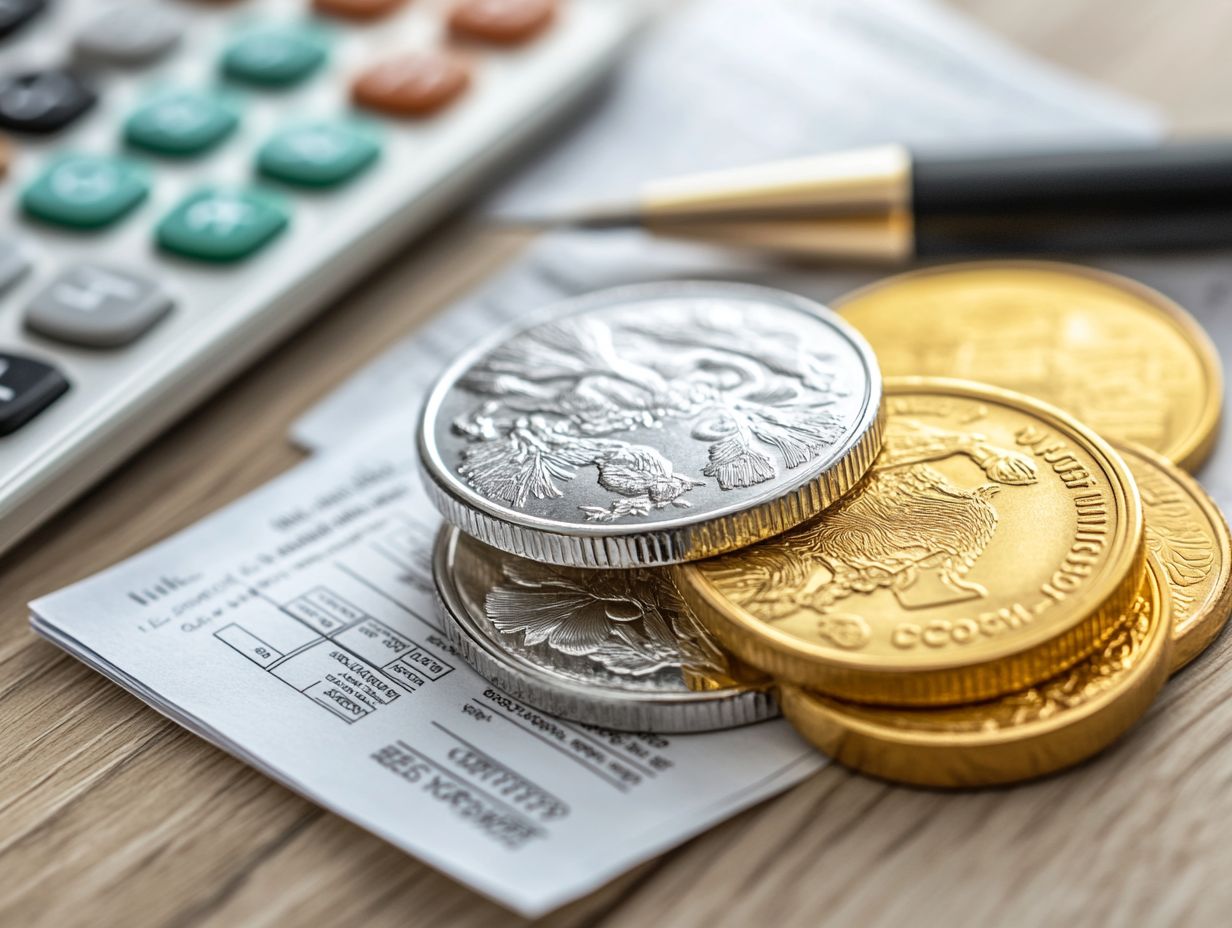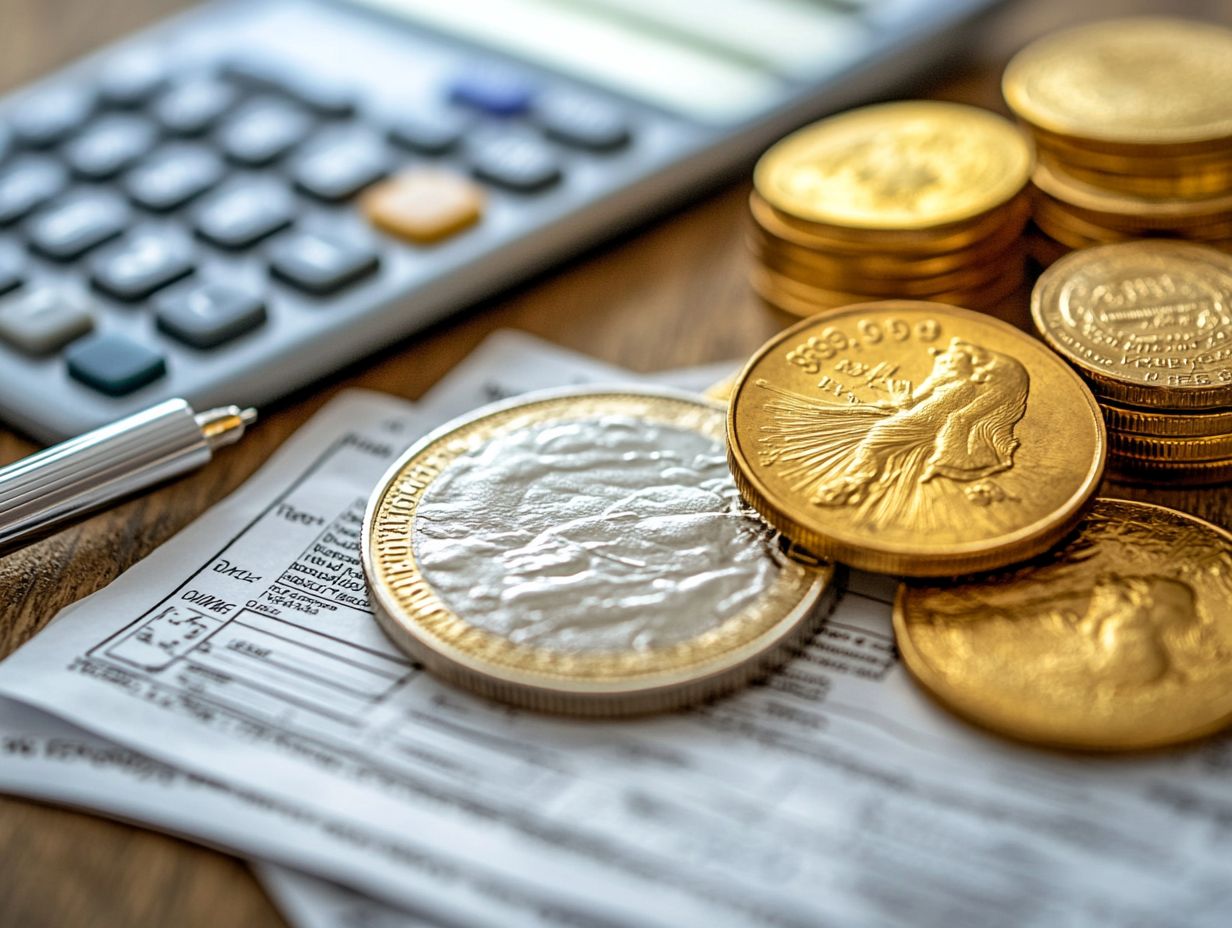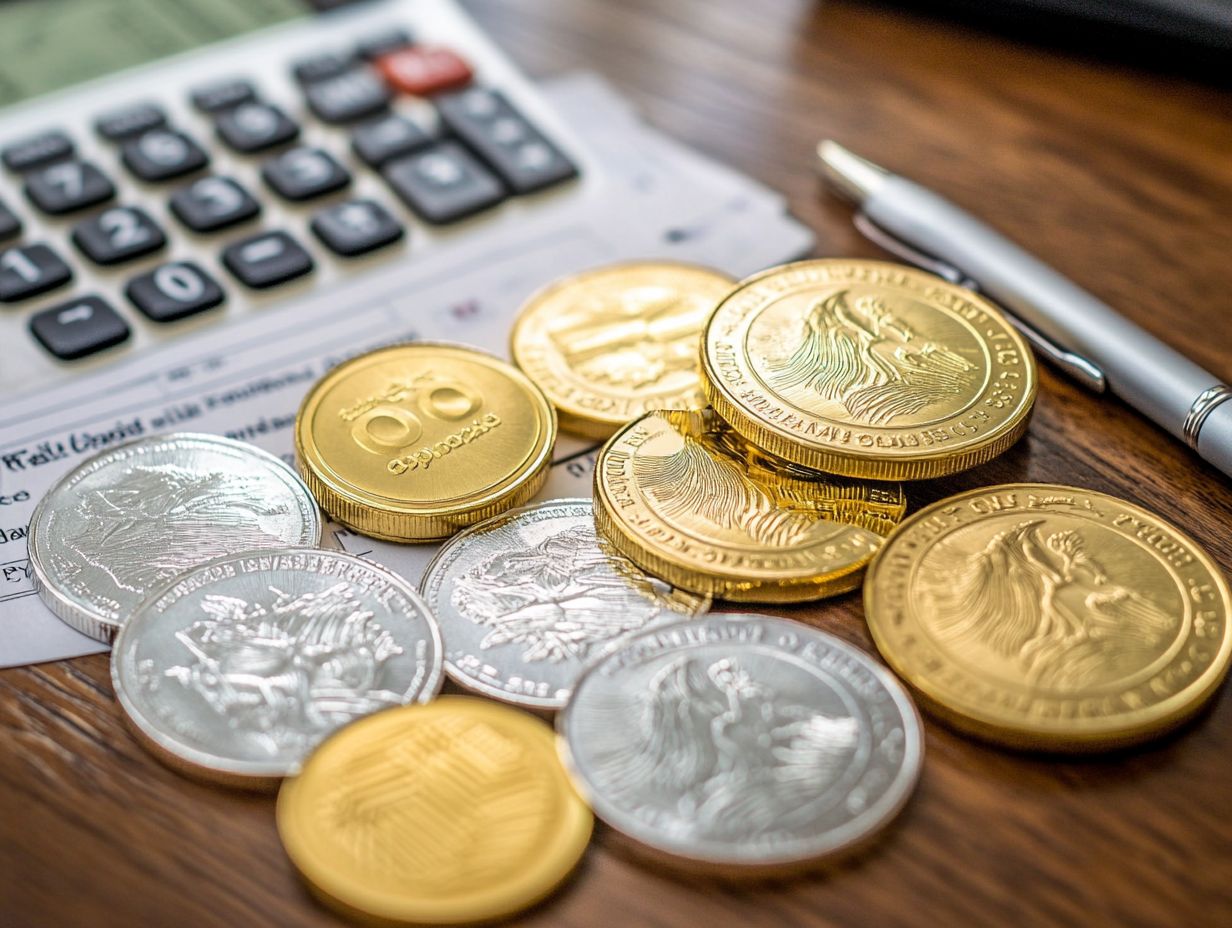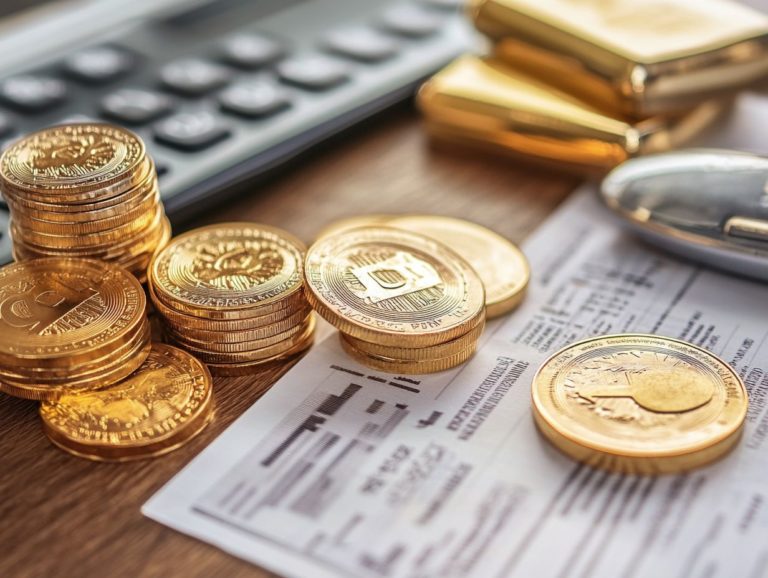Tax Implications of Investing in Precious Metals ETFs
Investing in Precious Metals ETFs can be a savvy move to diversify your portfolio. However, there’s more at stake than just the allure of potential profits.
Understanding tax implications is crucial for maximizing returns. This article explores tax benefits associated with these investments, such as lower capital gains tax rates and possible deductions for losses.
It also provides a detailed breakdown of the tax considerations for various types of Precious Metals ETFs gold, silver, platinum, and palladium along with essential insights on the tax implications when you decide to sell.
Get ready to confidently navigate the financial landscape of Precious Metals ETFs!
Contents
- Key Takeaways:
- Tax Benefits of Investing in Precious Metals ETFs
- Tax Considerations for Different Types of Precious Metals ETFs
- Tax Implications of Selling Precious Metals ETFs
- Frequently Asked Questions
- What are the tax implications of investing in precious metals ETFs?
- Are precious metals ETFs tax-deferred investments?
- Do I have to pay taxes on precious metals ETFs if I don’t sell?
- What is the tax rate for gains from precious metals ETFs?
- Are there any tax advantages to investing in precious metals ETFs?
- Can I hold precious metals ETFs in a tax-advantaged retirement account?
Key Takeaways:

- Investing in Precious Metals ETFs could result in lower capital gains tax rates compared to physical metals due to the “collectibles” tax rate being applied.
- If you experience losses from investing in Precious Metals ETFs, you may be able to claim tax deductions.
- When considering different types of Precious Metals ETFs, keep in mind that each may have unique tax considerations.
What are Precious Metals ETFs?
Precious Metals ETFs, or Exchange-Traded Funds, are innovative investment vehicles that allow you to gain exposure to the performance of precious metals like gold, silver, and platinum without the hassle of holding the physical assets yourself. These funds trade on stock exchanges and track the price movements of these metals, offering you a convenient and liquid way to invest in precious metals.
Often, they hold underlying assets such as gold coins and bullion. This makes them an appealing choice for diversifying your portfolio with tangible assets while navigating the complexities of capital markets.
For you as an investor, these ETFs come with several advantages, including ease of trading and lower storage costs compared to owning physical metals. Be aware that you might encounter annual management fees, and you won t have direct ownership of the underlying assets.
The IRS treats profits from these investments as collectibles, which could subject you to higher tax rates compared to standard investments like stocks.
Organizations like the World Gold Council provide you with valuable market insights. As you consider your investment strategies, it’s crucial to weigh the benefits and drawbacks of ETFs against physical holdings to ensure they align with your long-term financial goals.
Tax Benefits of Investing in Precious Metals ETFs
Investing in Precious Metals ETFs can offer you a range of tax benefits, making them an appealing choice if you’re aiming to maximize your returns while minimizing tax liabilities, particularly concerning capital gains tax.
These advantages arise from the unique structure of ETFs and their interaction with IRS regulations. This guides you through the complexities of taxation on precious metals investments.
For example, the tax implications can vary significantly between traditional precious metals IRAs and ETFs, enabling you to engage in strategic financial planning and optimize your investment approach.
Start your journey with Precious Metals ETFs today and explore how they can enhance your investment portfolio!
Lower Capital Gains Tax Rates
Investors in Precious Metals ETFs often enjoy lower capital gains tax rates, especially when they hold their investments for the long term. This can significantly enhance your overall return on investment. The IRS classifies these funds as securities, allowing for favorable tax treatment compared to the higher rates tied to collectibles like physical gold and silver.
Understand the differences between short-term and long-term gains. This knowledge helps you make informed decisions that support your financial goals.
If you sell your Precious Metals ETF shares after holding them for more than a year, you may qualify for long-term capital gains rates. These rates are generally more favorable than the short-term rates applied to shares sold within a year. This difference can significantly impact your net profits, as short-term gains are taxed as ordinary income.
Be mindful of your unique tax situation and plan your sales carefully.
Market conditions can fluctuate, requiring you to engage in strategic planning to optimize tax implications. This ensures that your investment strategies focus on maximizing potential returns while minimizing tax liabilities.
Tax Deductions for Losses
One valuable advantage of investing in Precious Metals ETFs is the potential for tax deductions on losses. This provides a cushion during market downturns. If you face losses in your ETFs, you may be able to deduct these losses from your taxable income, following IRS reporting requirements.
This strategy can significantly lessen the overall impact of poor performance on your investment portfolio, enhancing the tax efficiency of your precious metals investments.
Understanding how these deductions work is crucial for anyone involved in such investments. According to IRS guidelines, capital losses can offset capital gains. If your losses exceed your gains, you can reduce ordinary income up to a specified limit each year.
This approach helps manage tax liabilities and influences your overall investment strategy and risk management techniques. By factoring potential losses and their tax implications into your portfolio management, you can make informed decisions regarding asset allocation, effectively balancing risk and reward.
As a result, this aspect transforms your investment strategy into a more resilient framework against market volatility.
Tax Considerations for Different Types of Precious Metals ETFs

When considering tax implications, understanding the nuances of various Precious Metals ETFs like gold ETFs, silver ETFs, platinum ETFs, and palladium ETFs can greatly enhance your investment strategy.
Each ETF has its own set of tax considerations that can influence your overall returns, depending on how the IRS classifies them and the specific metals involved. Understanding these distinctions, along with tax strategies for maximizing returns in precious metals, is essential for optimizing your tax efficiency and ensuring your investments align seamlessly with your financial goals.
Gold ETFs
Gold ETFs present an appealing option for investors seeking exposure to gold without the complexities of storing gold bars or coins. They offer a convenient way to invest in gold, along with specific tax considerations. Classified by the IRS as securities, these funds typically subject you to capital gains tax the tax you pay on profits from selling investments upon selling shares.
However, they also have the potential for favorable tax treatment when held long-term. Understanding the tax effects of precious metals trading will help you make more informed financial decisions.
The structure of these exchange-traded funds often allows direct investment in physical gold. While you need to consider management fees, you ll save on the logistical costs associated with traditional gold investments. One standout benefit is the liquidity that ETFs provide, allowing you to buy or sell shares easily compared to conventional gold investments.
Stay informed about the unique tax implications of gold ETFs to maximize your returns! These are generally taxed at a higher rate than stocks. Capital gains tax can significantly affect your returns. For instance, if you hold a gold ETF for over a year, you may benefit from lower long-term capital gains rates. Understanding the role of precious metals in tax-deferred accounts highlights the importance of strategic timing when buying or selling your assets.
Silver ETFs
Silver ETFs offer an excellent opportunity to diversify your portfolio by gaining exposure to silver, one of the most actively traded precious metals. However, be mindful of the specific tax implications tied to this investment vehicle.
Like gold ETFs, silver ETFs are classified by the IRS as securities, which means you could be liable for capital gains tax when you sell. Understanding the tax strategies for investing in precious metals ETFs is crucial if you’re considering investing in silver.
The nature of capital gains tax can significantly impact your net returns, especially if you’re a short-term investor who might be taxed at a higher rate than those holding their investments long-term. To maximize your returns, it’s important to understand the role of precious metals in your tax strategy and carefully analyze your tax strategies, particularly when deciding whether to hold your silver ETFs for the long haul or pursue quicker profits.
Silver ETFs eliminate storage costs and risks associated with owning physical silver, making them a popular choice. Smart planning, including tax strategies for high-net-worth precious metals investors, is crucial to seize the best opportunities while mitigating tax liabilities and maximizing potential gains.
Platinum ETFs
Platinum ETFs provide a compelling way for you to diversify into platinum, a precious metal known for its rarity and industrial significance. However, consider the specific tax factors involved. Like other Precious Metals ETFs, platinum ETFs are classified as securities by the IRS, making them subject to capital gains tax when sold. Understanding these tax implications is essential if you’re contemplating investing in platinum through ETFs.
These securities can serve as a hedge against inflation and currency fluctuations, enhancing their appeal in uncertain economic times. When assessing performance, focus on elements like expense ratios the cost of managing your investment fund, liquidity, and historical returns, as these can profoundly influence your investment outcomes.
Strategically utilizing platinum ETFs might involve holding them long-term to lessen capital gains tax impacts or incorporating them into a broader portfolio as a short-term asset to take advantage of price volatility. Thorough research and understanding these dynamics will enable you to make informed investment decisions in the platinum market.
Palladium ETFs
Palladium ETFs offer a unique opportunity in precious metals investments. You can tap into the distinct market dynamics of palladium, but be aware of the tax implications tied to this asset class.
Similar to gold, silver, and platinum ETFs, palladium ETFs are classified as securities by the IRS. This means that capital gains tax will come into play when you sell your shares. Understanding the tax consequences of trading precious metals is essential if you’re considering an investment in palladium.
The palladium market is volatile, influenced by supply and demand factors. Be sure to evaluate your entry and exit points carefully. Recognizing how capital gains tax impacts your returns is vital, especially amid today’s fluctuating prices.
Strategic positioning in palladium ETFs can hedge against inflation and enhance diversification. However, being mindful of prolonged holding periods can help reduce tax burdens.
Ultimately, understanding the details of capital gains tax and using thoughtful investment strategies will enable you to optimize your portfolio effectively.
Tax Implications of Selling Precious Metals ETFs

When selling Precious Metals ETFs, understanding the tax implications is crucial. This knowledge helps you optimize returns while adhering to IRS regulations. Selling these ETFs can trigger capital gains tax liabilities that you need to report, which means you’ll have to navigate specific reporting requirements, including filling out Form 1099-B.
Being familiar with these obligations is essential for making informed financial decisions as you manage the complexities associated with precious metals investments.
Tax on Capital Gains
The tax on capital gains is an important consideration when selling Precious Metals ETFs. The tax rate varies dramatically based on whether your gains are classified as short-term or long-term.
The IRS defines short-term gains as those from assets held for one year or less, which means they re taxed at ordinary income tax rates.
In contrast, long-term gains benefit from reduced tax rates. Therefore, it’s crucial to think strategically about your holding periods to maximize returns. Understanding these distinctions helps you make more informed decisions about when to sell.
Short-term capital gains are taxed at your regular income tax rate, which could soar up to 37% based on your income bracket. On the other hand, long-term capital gains apply to investments held for over a year and are taxed at a maximum rate of 20% for high earners, with many qualifying for even lower rates of 0% or 15%.
To manage your portfolio effectively and minimize tax liabilities, develop a clear strategy to hold your Precious Metals ETFs for longer durations. Monitor market conditions and align your strategy with your individual financial goals.
You can also diversify your holdings and engage in tax-loss harvesting to offset gains, creating a more favorable tax landscape for you.
Reporting Requirements
Understanding the reporting requirements tied to selling Precious Metals ETFs is crucial for you as an investor. This knowledge helps you follow Internal Revenue Service (IRS) rules and avoid potential penalties.
When you sell your ETFs, you’ll generally need to report those transactions on your annual tax return. You’ll often use Form 1099-B, which outlines the proceeds from your sales. A solid grasp of these processes can make your tax filing experience smoother.
You should know that any gains you realize from these transactions could affect your overall tax liabilities. These gains may be categorized as capital gains. Keeping detailed records of your purchase prices, sale prices, and any associated fees will help you accurately report these transactions.
Along with Form 1099-B, you might also come across Form 8949, which helps reconcile gains and losses. By organizing your documentation in advance, you can understand tax reporting better, ensuring you meet all regulatory requirements effectively.
Frequently Asked Questions
Here are some common questions about investing in precious metals ETFs:
What are the tax implications of investing in precious metals ETFs?
Investing in precious metals ETFs can have various tax implications, depending on the type of ETF and the holding period. Generally, gains from selling precious metals ETFs are taxed as capital gains, either short-term or long-term depending on the holding period.
Are precious metals ETFs tax-deferred investments?

No, precious metals ETFs are not considered tax-deferred investments like traditional retirement accounts. Any gains from selling these ETFs will be taxed in the year they are realized, similar to other types of investments.
Do I have to pay taxes on precious metals ETFs if I don’t sell?
No, you will not have to pay taxes on precious metals ETFs if you do not sell them. Taxes are only applicable when gains are realized from selling the ETFs.
What is the tax rate for gains from precious metals ETFs?
The tax rate for gains from precious metals ETFs depends on the holding period. If the ETFs are held for less than a year, they are considered short-term gains and taxed at your regular income tax rate. If held for more than a year, they are considered long-term gains and taxed at a lower capital gains tax rate.
Are there any tax advantages to investing in precious metals ETFs?
Yes, investing in precious metals ETFs can offer some tax advantages. You can offset gains with losses from other investments, also known as tax-loss harvesting. ETFs that hold physical precious metals may qualify for long-term capital gains tax treatment, which is typically lower than income tax rates.
Can I hold precious metals ETFs in a tax-advantaged retirement account?
Yes, it is possible to hold precious metals ETFs in certain tax-advantaged retirement accounts, such as a self-directed IRA. However, there may be restrictions and fees associated with holding ETFs in these accounts. It is important to consult with a financial advisor or tax professional before making any decisions.















